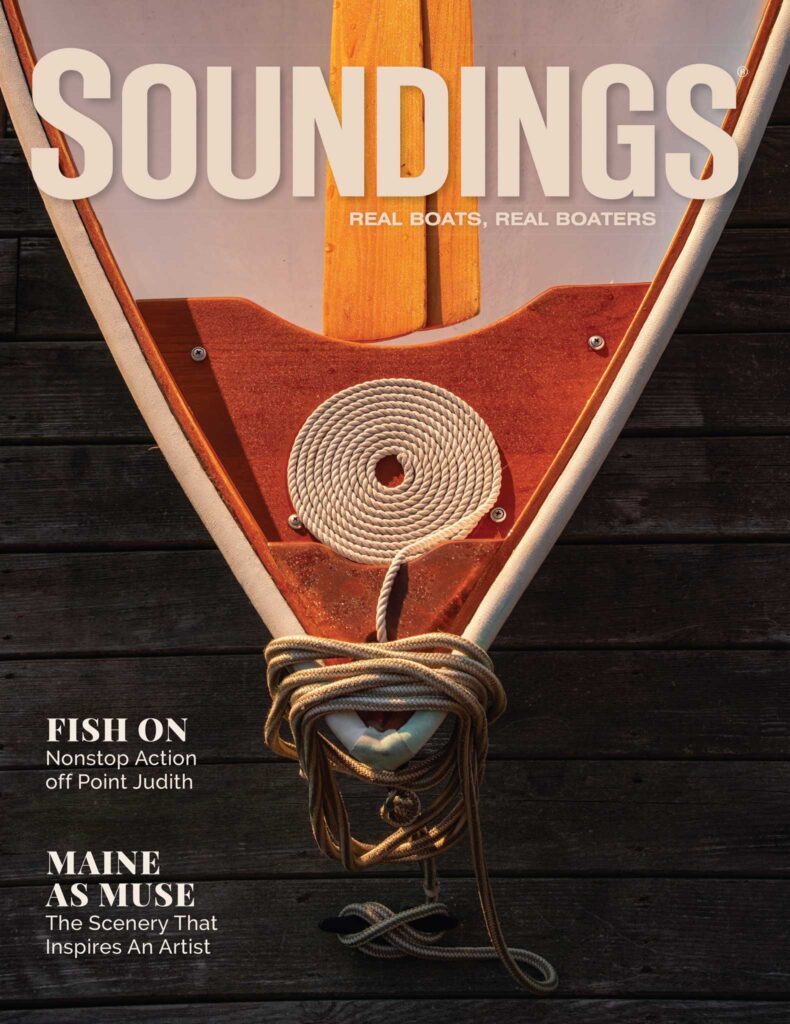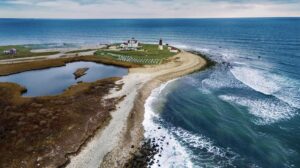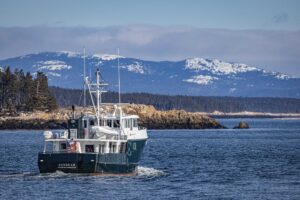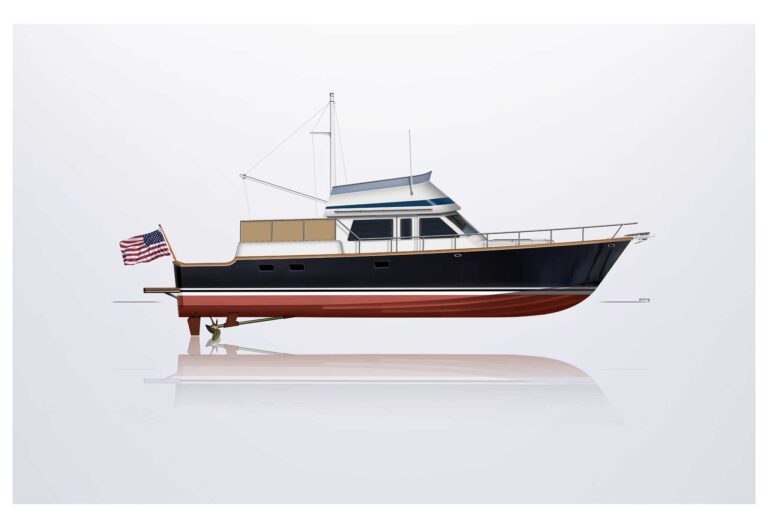When a catamaran overturns in heavy seas, it sets off a chain of events for the three-person crew
It was one heck of a summer for Kristy Lugert. A few weeks after the Alameda, Calif., resident bought a 32-foot sailing catamaran (her first large boat), she and her boyfriend found themselves battling 15-foot seas off Northern California. A wave flipped the cat, and when Lugert and her boyfriend thought they were going to die, they declared themselves married.

A Coast Guard helicopter plucked them from the overturned boat in a rescue basket, and a week later they were legally married – and eight weeks after that they decided to get divorced. The saga shifted back to the sea when Lugert helped her brother tow the cat home after he salvaged it.
“Wow, it’s been so crazy,” says Lugert, 46, who bought the 1999 PDQ 32 with her father, Jerry Lugert, in mid-June in Sidney, British Columbia. “There’s been so much drama from the very beginning.” The twists and turns continued right up until press time, when Lugert informed Soundings that the “marriage was back on.”
It all began when Lugert, who has primarily sailed catamarans in the Gulf of Mexico, fired her delivery captain and sailed the boat – along with her boyfriend, Steve McCarthy, 42, and Greg McCuen, 40 – on the last leg of the trip home, from Crescent City, Calif., around Cape Mendocino to Alameda. Lugert says she dismissed her delivery captain because he broke the agreed-upon float plan and failed to communicate with her during the trip.
T-boned
The boat capsized around noon July 3 some 20 miles off Fort Bragg, Calif., in heavy seas and 45-knot winds. “We got hit by a rogue wave and it was a lot steeper and a lot deeper than anything else we had been dealing with,” Lugert says. “It hit on the port side … and the boat went up on its side and turtled immediately.”
All three sailors – along with Lugert’s border collie, Jakey – were in the cockpit when the cat went over. McCarthy was at the helm. “The wave hit us like a train, basically T-boning us,” he says. “The wind came underneath the boat and finished the role.”

McCarthy, Lugert, McCuen and the dog were trapped under the boat in the space created by the cockpit. McCarthy activated the EPIRB – a GPS-enabled model rented from BoatU.S. – and
McCuen, the strongest swimmer, swam to the surface with the beacon and tied it to one of the 9.9-hp Yamaha outboards. All three sailors were wearing life jackets, but Lugert and McCarthy had to remove theirs so they could swim beneath the boat and out of the cockpit. McCuen was able to keep his PFD on. Lugert swam out after McCuen and McCarthy followed.
“Every time the boat rose and sank it would let more air out and it wouldn’t come back in,” says McCarthy, who has been sailing offshore since he was a teen and has sailed with McCuen for 16 years. “All of a sudden [the water] was up around my chin. I knew I had to get out. I took the last breath of air and had to say goodbye to Jakey.”
The three sailors tethered themselves together and to one of the outboards. They hung on for about three hours, Lugert says. “We just huddled together and sat there and protected the GPIRB and made sure it was working and giving a signal,” she says. “It was a pretty rough ride out there because the mainsail had managed to unfurl itself and turn the boat into the wind, so all the breakers were coming down on us.”
The sailors were fully clothed and the water temperature was about 50 F. Lugert says they had no survival suits aboard. Disoriented, hypothermic and facing death, Lugert and McCarthy pronounced themselves married. A Coast Guard helicopter from Group/Air Station Humboldt Bay, Calif., rescued them a short time later.
“We married ourselves on the back of the boat and we didn’t expect to live,” Lugert says. “We had only known each other for a few months. We weren’t engaged or anything; there was no plan to get married. When we did that, we thought we were going to be dead in 10 minutes.”
About a week after the rescue, Lugert and
McCarthy were legally married in Oakland, Calif., before a justice of the peace, surrounded by family members, Lugert says.
Beacon was dad’s idea
Lugert says the GPIRB, which her father had rented for the trio the day before they left Crescent City, saved their lives. “That was completely my dad’s idea,” she says. “I give him full credit for our survival. If he hadn’t rented [the GPIRB], we wouldn’t be here today.” Lugert says the catamaran had an EPIRB, but it was an older model.
Jerry Lugert, 73, also of Alameda, got the GPIRB through the BoatU.S. Foundation’s EPIRB Rental Program. “I had [it] shipped overnight,” he says. “Offshore you need all the weapons you can get and then some.”

Since the program’s inception in 1996, EPIRBs have been rented more than 5,000 times and their use has led to 65 lives saved, says Scott Croft, BoatU.S. assistant vice president of public relations. The BoatU.S. Foundation has added GPIRBs (an EPIRB with built-in GPS) to the program, which are easier to ship, easier to store and provide a more accurate location fix, which can mean speedier rescues, he says.
Boaters can rent McMurdo Smartfind Plus GPS-enabled EPIRBs – which retail for about $800 – for $65 a week, Croft says (www.BoatUS.com/Founda tion/epirb). “It’s a great way to improve personal safety while saving money for anyone who has an occasional need for an emergency rescue beacon,” Croft says.
Weather looked OK
Before they departed on the morning of July 2, the sailors looked over a weather report that called for 15- to 25-knot winds 10 nautical miles out. “We all read the weather report and agreed what our course would be to make it around [Cape Mendocino],” Lugert says. “It’s very difficult to find a day when it’s flat out there around the cape. I don’t think we knew it was going to be that bad.”
The PDQ 32 is a great cruising boat, but it’s not an offshore passagemaker, Lugert and McCarthy say. “The PDQ should have never been out there,” Lugert says. “It’s important for PDQ owners to know that nothing broke on the boat. I had put $3,000 worth of new rigging on the boat before it left. The boat was in perfect condition. It surveyed well above average, which is why I bought it. The boat is extremely strong.”
The Pacific pounded the cat, but it held together, McCarthy says. “The boat was out of its element,” he says. “The seas were really big. They were steep and the wave span was really small. There were a lot of them in a short period.”
They had been sailing for 24 hours and were about halfway through the 300-mile passage when the boat went over. “Part of the reason we survived was that we did flip in the daytime, the warmest part of the day, instead of the night,” Lugert says. “We never would have made it if it had been dark.”
Even with daylight, it was difficult for Coast Guard rescuers to see the overturned hull, says Lt. George Suchanek, a co-pilot on the MH-65C Dolphin helicopter that responded to the emergency. “The bottom of the hull was white and there were whitecaps all over the water from the high winds,” says Suchanek, who estimates seas were 16 feet, with an occasional 20- to 25-foot wave.
The sailors were lifted one by one to the helicopter. Suchanek says they were “severely hypothermic, so they were completely out of it. They were so cold that they really couldn’t talk. You could tell they didn’t have much time left,” he says.
Cat salvaged
The PDQ was a complete loss, destined to break up on the rocky California coast. But Lugert’s brother, Jerry, says he wanted this story to have a better ending. With the help of a friend, Les Watermann, who owns a 54-foot Chris-Craft, Lugert’s brother salvaged the boat and intends to use it as a floating office and to conduct marine propulsion experiments.
“We’re going to put some German electric motors in it, 10 hp,” the 43-year-old inventor says. “It was a sailboat and now it’s a powerboat.”
Watermann used his 1956 Chris-Craft – with twin 280-hp 6-71 Detroit diesels – to tow the catamaran from just south of Albion, Calif., to Treasure Island in San Francisco Bay. The boat had hung up on some rocks in a cove, but Lugert and Watermann were able to free it. Making only 1 mph, Watermann towed the boat – still upside-down – six miles to a beach so it could be righted and pumped out. Jerry Lugert hired professional divers, who used air bags to lift one side of the boat about 60 degrees; Watermann then righted the catamaran. They towed the boat as close to shore as possible and waited for the tide to go out.
“When it was high and dry, we pumped it out, and the rest is history,” says Watermann, 73, a retired crop-duster pilot who lives on the Chris-Craft. “They’re good people and it makes me feel good to help good people.”
Lugert went along with her brother on the trip from Albion to San Francisco Bay, dedicating the trip to her dog. (Two friends of Jerry Lugert’s – Daniel Gray and Matt Bissett – served as crew aboard the catamaran.)
“My brother wanted me to find some closure to all of this,” says Lugert, speaking with Soundings by phone as she took the helm of the cat under tow and approached the Golden Gate Bridge. “That’s why he cleaned the boat up and we went.”
This article originally appeared in the January 2011 issue.










